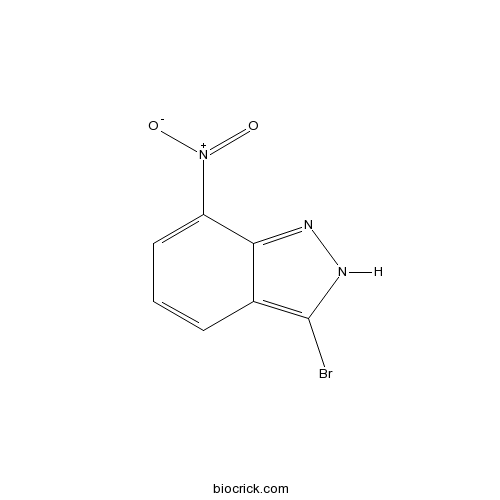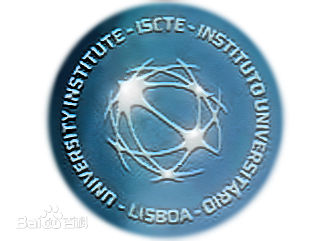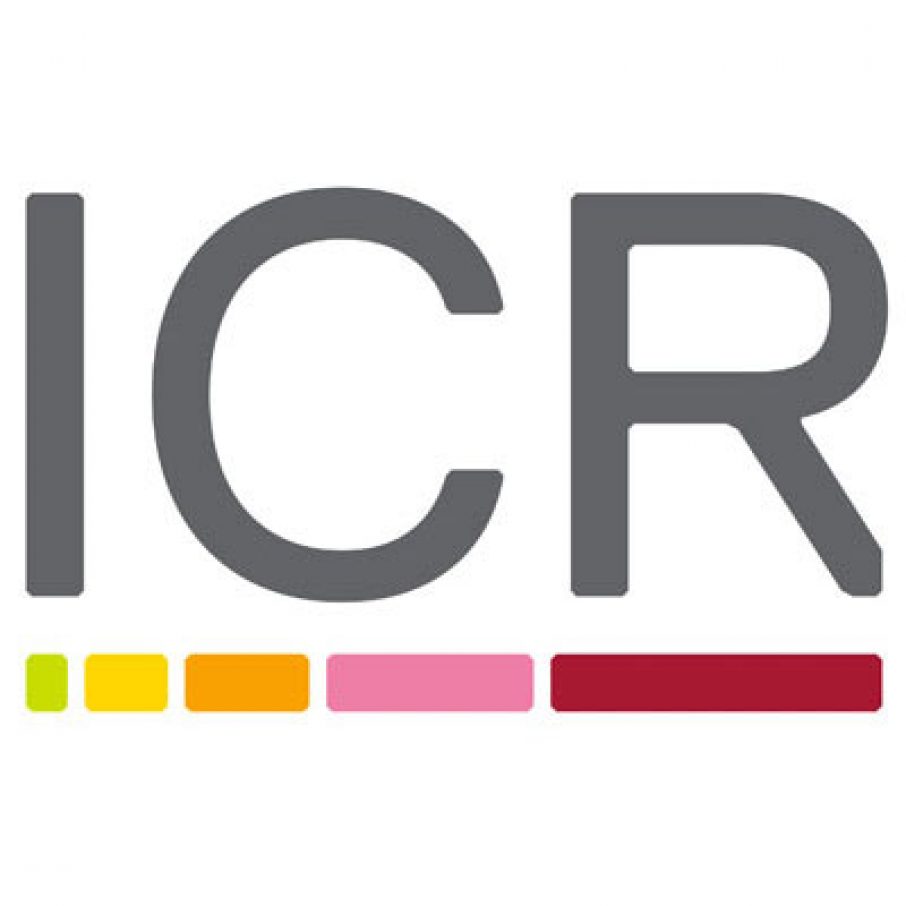3-Bromo-7-nitroindazoleCAS# 74209-34-0 |

- BAM7
Catalog No.:BCC1397
CAS No.:331244-89-4
- Bendamustine HCl
Catalog No.:BCC1153
CAS No.:3543-75-7
- Capsaicin
Catalog No.:BCN1016
CAS No.:404-86-4
- Betulinic acid
Catalog No.:BCN5524
CAS No.:472-15-1
- Brassinolide
Catalog No.:BCC1438
CAS No.:72962-43-7
Quality Control & MSDS
3D structure
Package In Stock
Number of papers citing our products

| Cas No. | 74209-34-0 | SDF | Download SDF |
| PubChem ID | 1649 | Appearance | Powder |
| Formula | C7H4BrN3O2 | M.Wt | 242.03 |
| Type of Compound | N/A | Storage | Desiccate at -20°C |
| Solubility | Soluble to 100 mM in DMSO and to 50 mM in ethanol | ||
| Chemical Name | 3-bromo-7-nitro-2H-indazole | ||
| SMILES | C1=CC2=C(NN=C2C(=C1)[N+](=O)[O-])Br | ||
| Standard InChIKey | NFSTZPMYAZRZPC-UHFFFAOYSA-N | ||
| Standard InChI | InChI=1S/C7H4BrN3O2/c8-7-4-2-1-3-5(11(12)13)6(4)9-10-7/h1-3H,(H,9,10) | ||
| General tips | For obtaining a higher solubility , please warm the tube at 37 ℃ and shake it in the ultrasonic bath for a while.Stock solution can be stored below -20℃ for several months. We recommend that you prepare and use the solution on the same day. However, if the test schedule requires, the stock solutions can be prepared in advance, and the stock solution must be sealed and stored below -20℃. In general, the stock solution can be kept for several months. Before use, we recommend that you leave the vial at room temperature for at least an hour before opening it. |
||
| About Packaging | 1. The packaging of the product may be reversed during transportation, cause the high purity compounds to adhere to the neck or cap of the vial.Take the vail out of its packaging and shake gently until the compounds fall to the bottom of the vial. 2. For liquid products, please centrifuge at 500xg to gather the liquid to the bottom of the vial. 3. Try to avoid loss or contamination during the experiment. |
||
| Shipping Condition | Packaging according to customer requirements(5mg, 10mg, 20mg and more). Ship via FedEx, DHL, UPS, EMS or other couriers with RT, or blue ice upon request. | ||
| Description | Potent inhibitor of rat cerebellar nitric oxide synthase; more potent than 7-nitroindazole. |

3-Bromo-7-nitroindazole Dilution Calculator

3-Bromo-7-nitroindazole Molarity Calculator
| 1 mg | 5 mg | 10 mg | 20 mg | 25 mg | |
| 1 mM | 4.1317 mL | 20.6586 mL | 41.3172 mL | 82.6344 mL | 103.293 mL |
| 5 mM | 0.8263 mL | 4.1317 mL | 8.2634 mL | 16.5269 mL | 20.6586 mL |
| 10 mM | 0.4132 mL | 2.0659 mL | 4.1317 mL | 8.2634 mL | 10.3293 mL |
| 50 mM | 0.0826 mL | 0.4132 mL | 0.8263 mL | 1.6527 mL | 2.0659 mL |
| 100 mM | 0.0413 mL | 0.2066 mL | 0.4132 mL | 0.8263 mL | 1.0329 mL |
| * Note: If you are in the process of experiment, it's necessary to make the dilution ratios of the samples. The dilution data above is only for reference. Normally, it's can get a better solubility within lower of Concentrations. | |||||

Calcutta University

University of Minnesota

University of Maryland School of Medicine

University of Illinois at Chicago

The Ohio State University

University of Zurich

Harvard University

Colorado State University

Auburn University

Yale University

Worcester Polytechnic Institute

Washington State University

Stanford University

University of Leipzig

Universidade da Beira Interior

The Institute of Cancer Research

Heidelberg University

University of Amsterdam

University of Auckland

TsingHua University

The University of Michigan

Miami University

DRURY University

Jilin University

Fudan University

Wuhan University

Sun Yat-sen University

Universite de Paris

Deemed University

Auckland University

The University of Tokyo

Korea University
- Uplandicine
Catalog No.:BCN2055
CAS No.:74202-10-1
- Doxazosin
Catalog No.:BCC4218
CAS No.:74191-85-8
- Cyclokievitone
Catalog No.:BCC8159
CAS No.:74175-82-9
- Haginin A
Catalog No.:BCN6861
CAS No.:74174-29-1
- R547
Catalog No.:BCC3927
CAS No.:741713-40-6
- 2,3-Dehydrokievitone
Catalog No.:BCN4294
CAS No.:74161-25-4
- Pimobendan
Catalog No.:BCC2294
CAS No.:74150-27-9
- Bisdethiobis(methylthio)gliotoxin
Catalog No.:BCN7351
CAS No.:74149-38-5
- DSC
Catalog No.:BCC2800
CAS No.:74124-79-1
- Norjuziphine
Catalog No.:BCN3367
CAS No.:74119-87-2
- SKF 83822 hydrobromide
Catalog No.:BCC7252
CAS No.:74115-10-9
- Ketorolac tromethamine salt
Catalog No.:BCC4431
CAS No.:74103-07-4
- Vintafolide
Catalog No.:BCC5265
CAS No.:742092-03-1
- Carbenoxolone disodium
Catalog No.:BCC3745
CAS No.:7421-40-1
- OSU-03012 (AR-12)
Catalog No.:BCC1255
CAS No.:742112-33-0
- Doronenine
Catalog No.:BCN2066
CAS No.:74217-57-5
- Baogongteng A
Catalog No.:BCN1874
CAS No.:74239-84-2
- p-Chlorophenylalanine
Catalog No.:BCC5689
CAS No.:7424-00-2
- 7-Acetylintermedine
Catalog No.:BCN1998
CAS No.:74243-01-9
- 12-Oxograndiflorenic acid
Catalog No.:BCN7624
CAS No.:74284-42-7
- Triptophenolide
Catalog No.:BCN2546
CAS No.:74285-86-2
- Sinapine thiocyanate
Catalog No.:BCN2765
CAS No.:7431-77-8
- Quercetin-3-gentiobioside
Catalog No.:BCN3878
CAS No.:7431-83-6
- Somatostatin 1-28
Catalog No.:BCC5715
CAS No.:74315-46-1
3-bromo-7-nitroindazole, a neuronal nitric oxide synthase inhibitor, impairs maternal aggression and citrulline immunoreactivity in prairie voles.[Pubmed:10869504]
Brain Res. 2000 Jul 7;870(1-2):80-6.
Lactating female rodents are aggressive against intruders when they are rearing and protecting pups. In prairie voles, Microtus ochrogaster, females exhibit a dramatic increase in citrulline immunoreactivity (citrulline-IR) in the paraventricular nucleus (PVN), but not in control regions of the brain, in association with maternal aggression. Citrulline is an indirect indicator of nitric oxide (NO) synthesis and it is possible that NO release in the PVN is an important element in the control of maternal aggression in prairie voles. In this study, we sought to examine the role of NO in maternal aggression by selectively inhibiting neuronal nitric oxide synthase (nNOS) in lactating prairie voles. Intraperitoneal injections of the nNOS inhibitor, 3-Bromo-7-nitroindazole (3-Br-7NI) (20 mg/kg), three time per day over 4 days resulted in significant impairment of the expression of maternal aggression in terms of the average time in aggressive encounters, the average number of attacks, and the average latency to first attack. These behavioral deficiencies were observable beginning two days following the onset of drug treatment. The average time spent sniffing the intruder was indistinguishable between the 3-Br-7NI- and oil-treated females. In 3-Br-7NI-treated relative to oil-treated females, the number of citrulline-positive cells was reduced by 70% in the PVN and by 50% in the anterior amygdaloid area, a control region of the brain. Taken together, these results indicate that 3-Br-7NI effectively inhibits maternal aggression and NO production in prairie voles and suggest that the central release of NO may play an important role in the production of maternal aggression in prairie voles.
The effect of a selective neuronal nitric oxide synthase inhibitor 3-bromo 7-nitroindazole on spatial learning and memory in rats.[Pubmed:25636602]
Pharmacol Biochem Behav. 2015 Apr;131:19-25.
Since the discovery of nitric oxide (NO) as a neuronal messenger, its way to modulate learning and memory functions is subject of intense research. NO is an intercellular messenger in the central nervous system and is formed on demand through the conversion of L-arginine to L-citrulline via the enzyme nitric oxide synthase (NOS). Neuronal form of nitric oxide synthase may play an important role in a wide range of physiological and pathological conditions. Therefore the aim of this study was to investigate the effects of chronic 3-bromo 7-nitroindazole (3-Br 7-NI), specific neuronal nitric oxide synthase (nNOS) inhibitor, administration on spatial learning and memory performance in rats using the Morris water maze (MWM) paradigm. Male rats received either 3-Br 7-NI (20mg/kg/day) or saline via intraperitoneal injection for 5days. Daily administration of the specific neuronal nitric oxide synthase (nNOS) inhibitor, 3-Br 7-NI impaired the acquisition of the MWM task. 3-Br 7-NI also impaired the probe trial. The MWM training was associated with a significant increase in the brain-derived neurotrophic factor (BDNF) mRNA expression in the hippocampus. BDNF mRNA expression in the hippocampus did not change after 3-Br 7-NI treatment. L-arginine significantly reversed behavioural parameters, and the effect of 3-Br 7-NI was found to be NO-dependent. There were no differences in locomotor activity and blood pressure in 3-Br 7-NI treated rats. Our results may suggest that nNOS plays a key role in spatial memory formation in rats.
3-Bromo-7-nitroindazole attenuates brain ischemic injury in diabetic stroke via inhibition of endoplasmic reticulum stress pathway involving CHOP.[Pubmed:22075494]
Life Sci. 2012 Jan 16;90(3-4):154-60.
AIMS: The role of nitric oxide (NO) and endoplasmic reticulum (ER) stress has been implicated in the pathogenesis of cerebral ischemic/reperfusion (I/R) injury and diabetes. The aim of the study was to investigate the neuroprotective potential of 3-Bromo-7-nitroindazole (3-BNI), a potent and selective neuronal nitric oxide synthase (nNOS) inhibitor against ER stress and focal cerebral I/R injury associated with comorbid type 2 diabetes in-vivo. MAIN METHODS: Type 2 diabetes was induced by feeding high-fat diet and streptozotocin (35 mg/kg) treatment in rats. Focal cerebral ischemia was induced by 2h middle cerebral artery occlusion (MCAO) followed by 22 h of reperfusion. Immunohistochemistry and western blotting methods were employed for the detection and expression of ER stress/apoptosis markers [78 kDa glucose regulated protein (GRP78) and CCAAT/enhancer binding protein homologous protein (CHOP)]. TUNEL assay for DNA fragmentation was also performed. KEY FINDINGS: The diabetic rats subjected to cerebral I/R had prominent neurological damage and functional deficits compared with sham-operated rats. Massive DNA fragmentation was observed in ischemic penumbral region of diabetic brains. Concomitantly, the enhanced immunoreactivity and expression of ER stress/apoptosis markers were noticed. 3-BNI (30 mg/kg, i.p.) treatment significantly inhibited the cerebral infarct, edema volume and improved functional recovery of neurological deficits. The neuroprotection was further evident by lesser DNA fragmentation with a concomitant reduction of GRP78 and CHOP. SIGNIFICANCE: The study demonstrates the neuroprotective potential of 3-BNI in diabetic stroke model which may be partly due to inhibition of ER stress pathway involving CHOP.
7-Nitro indazole derivatives are potent inhibitors of brain, endothelium and inducible isoforms of nitric oxide synthase.[Pubmed:7544863]
Life Sci. 1995;57(11):PL131-5.
The effect of 7-nitro indazole (7-NI) and a range of substituted indazole derivatives on nitric oxide synthase (NOS) enzyme activity in homogenates of rat cerebellum, bovine endothelial cells and lung from endotoxin-pretreated rats was investigated. 3-bromo 7-nitro indazole was either equipotent (IC50, 0.86 +/- 0.05 microM c.f. 0.78 +/- 0.2 microM, n = 6, P > 0.05) or approximately 4x (IC50, 0.17 +/- 0.01 microM c.f. 0.71 +/- 0.01 microM, n = 6, P < 0.05) or 20x (IC50, 0.29 +/- 0.01 microM c.f. 5.8 +/- 0.4 microM, n = 6, P < 0.05) more potent than 7-NI as an inhibitor of bovine endothelial, rat cerebellar and rat lung NOS enzyme activity respectively. 2,7-dinitro indazole also inhibited NOS in all three tissue sources with a potency similar to that of 7-NI. These results suggest that 3-bromo 7-NI and 2,7-dinitro indazole may prove to be useful additional tools with which to examine the biological properties of nitric oxide (NO).


